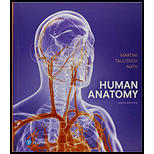
To review:
Match the term coronary circulation with the most closely related descriptions given below:
Vein to the left atrium
Covers outer surface of the heart
Supplies blood to heart muscle
Lines inner surface of fibrous pericardium
Slow heart rate
Functional syncytium
Muscular wall of the heart
Relaxation phase of the cardiac cycle
Vein to the right atrium
Contraction phase of the cardiac cycle
Introduction:
The heart supplies blood to all parts of the body through two circulations—pulmonary and systemic. The systemic circulation ensures a supply of blood to all the body organs except the lungs. The pulmonary circulation takes place between the heart and the lungs. In this way, the blood is oxygenated and returns to the heart. There is another kind of blood circulation, known as coronary circulation.
Want to see the full answer?
Check out a sample textbook solution
Chapter 21 Solutions
Human Anatomy (9th Edition)
- Blood flow through the capillaries is steady despite the rhythmic pumping action of the heart because of the (a) elasticity of the large arteries only, (b) elasticity of all the arteries, (c) ligamentum arteriosum, (d) venous valves.arrow_forwardList the major blood vessels and their origins involved in coronary circulation. (ii) At what stage or phase of the heart’s activities does the heart tissues becomes perfused with oxygenated blood? (iii) Define myocardial infarction. (iv) Explain the typical signs associated with acute myocardial infarction. (v) Outline/State which arteries of the heart are most commonly affected/occluded. (vi) Explain why occlusions lead to infarct in the heart. (vii) What is creatine phosphokinase (CPK) and why are elevated CPK levels in the blood suggestive of a myocardial infarction? (viii) What is cor pulmonale? (ix) Describe the main clinical findings (with cor pulmonale) on examination. Explain your answer.arrow_forwardBlood within the veins is prevented from flowing away from the heart because of the presence of: (a) venous reservoirs. (b) muscular walls. (c) clots. (d) valves.arrow_forward
- (a) What is the cardiac cycle? (b) What phases and events are necessary to complete the cardiac cycle?arrow_forwardAt the end of ...........,the ventricles are 70% filled.arrow_forward(a) Mention any two components of blood. (b) Trace the movement of oxygenated blood in the body. (c) Write the function of valves present in between atria and ventricles. (d) Write one structural difference between the composition of artery and veins.arrow_forward
- (a) Describe how heart contraction and relaxation influence coronary blood flow. (b) Name the major branches of the coronary arteries, and note the heart regions served by each.arrow_forwardThe unpaired arteries supplying blood to the visceral organs include the (a) adrenal, renal, and lumbar arteries. (b) iliac, gonadal, and femoral arteries. (c) celiac trunk and superior and inferior mesenteric arteries. (d) a, b, and c are correct.arrow_forwardThe two factors that assist the relatively low venous pressures in propelling blood toward the heart are (a) ventricular systole and valve closure. (b) gravity and vasomotion. (c) muscular compression and the respiratory pump. (d) atrial and ventricular contractions.arrow_forward
- The blood vessels that collect blood from all tissues and organs and return it to the heart are the, (a) veins. (b) arteries. (c) capillaries. (d) arterioles.arrow_forward(a) What are the primary forces that cause fluid to move out of a capillary and into the interstitial fluid at its arterial end? (b) What are the primary forces that cause fluid to move into a capillary from the interstitial fluid at its venous end?arrow_forwardThe middle cardiac vein runs with which artery? (a) marginal artery, (b) aorta, (c) coronary sinus, (d) anterior interventricular artery, (e) posterior interventricular artery.arrow_forward
 Human Anatomy & Physiology (11th Edition)BiologyISBN:9780134580999Author:Elaine N. Marieb, Katja N. HoehnPublisher:PEARSON
Human Anatomy & Physiology (11th Edition)BiologyISBN:9780134580999Author:Elaine N. Marieb, Katja N. HoehnPublisher:PEARSON Biology 2eBiologyISBN:9781947172517Author:Matthew Douglas, Jung Choi, Mary Ann ClarkPublisher:OpenStax
Biology 2eBiologyISBN:9781947172517Author:Matthew Douglas, Jung Choi, Mary Ann ClarkPublisher:OpenStax Anatomy & PhysiologyBiologyISBN:9781259398629Author:McKinley, Michael P., O'loughlin, Valerie Dean, Bidle, Theresa StouterPublisher:Mcgraw Hill Education,
Anatomy & PhysiologyBiologyISBN:9781259398629Author:McKinley, Michael P., O'loughlin, Valerie Dean, Bidle, Theresa StouterPublisher:Mcgraw Hill Education, Molecular Biology of the Cell (Sixth Edition)BiologyISBN:9780815344322Author:Bruce Alberts, Alexander D. Johnson, Julian Lewis, David Morgan, Martin Raff, Keith Roberts, Peter WalterPublisher:W. W. Norton & Company
Molecular Biology of the Cell (Sixth Edition)BiologyISBN:9780815344322Author:Bruce Alberts, Alexander D. Johnson, Julian Lewis, David Morgan, Martin Raff, Keith Roberts, Peter WalterPublisher:W. W. Norton & Company Laboratory Manual For Human Anatomy & PhysiologyBiologyISBN:9781260159363Author:Martin, Terry R., Prentice-craver, CynthiaPublisher:McGraw-Hill Publishing Co.
Laboratory Manual For Human Anatomy & PhysiologyBiologyISBN:9781260159363Author:Martin, Terry R., Prentice-craver, CynthiaPublisher:McGraw-Hill Publishing Co. Inquiry Into Life (16th Edition)BiologyISBN:9781260231700Author:Sylvia S. Mader, Michael WindelspechtPublisher:McGraw Hill Education
Inquiry Into Life (16th Edition)BiologyISBN:9781260231700Author:Sylvia S. Mader, Michael WindelspechtPublisher:McGraw Hill Education





